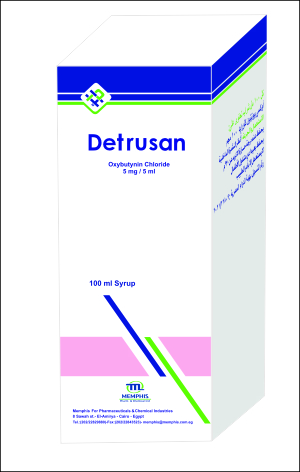TRADE NAME: Detrusan Syrup GENERIC NAME: Oxybutynin chloride COMPOSITION: Each 5 ml syrup contains: Active ingredient: Oxybutynin chloride 5 mg : Excipients Propylene glycol, Citric acid monohydrate, Sodium citrate tribasic, Sorbitol 70%, Aspartame, sucrose, Methyl paraben, propyl paraben, Orange cacao flavour, Distilled water. PHARMACEUTICAL FORM: Clear colorless solution to pale yellow with palatable taste syrup. PHARMACOLOGICAL ACTION: PHARMACODYNAMICS: Mechanism of Action Oxybutynin chloride is a tertiary amine anticholinergic agent which exerts antimuscarinic as well as direct antispasmodic action on smooth muscle. In vitro studies have shown that its anticholinergic effects are weaker than those of atropine, but it possesses greater antispasmodic activity. No blocking effects occur at skeletal neuromuscular junctions or in autonomic ganglia (no antinicotinic effects). In addition to its smooth muscle relaxing effects, oxybutynin chloride exerts an analgesic and a local anesthetic effect. In animal studies, the central nervous system and cardiovascular actions of oxybutynin chloride were shown to be similar to but weaker than those of atropine. Oxybutynin chloride relaxes bladder smooth muscle. In patients with uninhibited neurogenic and reflex neurogenic bladder, cystometric studies have demonstrated that oxybutynin chloride increases bladder (vesical) capacity, diminishes the frequency of uninhibited contractions of the detrusor muscle, and delays the initial desire to void. Oxybutynin chloride thus decreases urgency and the frequency of both incontinent episodes and voluntary urination. These effects are more consistently improved in patients with uninhibited neurogenic bladder. PHARMACOKINETICS: Absorption: Following oral administration of OXYBUTYNIN SYRUP, oxybutynin chloride is rapdily absorbed achieving Cmax within an hour, following which plasma concentration decreases with an effective half-life of approximately 2 to 3 hours. The absolute bioavailability of oxybutynin chloride is reported to be about 6% (range 1.6% to 10.9%) for both the tablet and syrup. Wide interindividual variation in pharmacokinetic parameters is evident following oral administration of oxybutynin. The mean pharmacokinetic parameters for R- and S-oxybutynin are summarized in Table 1.2. Table 1.2: Mean (SD) R- and S-Oxybutynin Pharmacokinetic Parameters Following Three Doses of oxybutynin chloride 5 mg Administered Every 8 Hours (n = 23) Parameters (units) R-Oxybutynin S-Oxybutynin Cmax (ng/mL) 3.6 (2.2) 7.8 (4.1) Tmax (h) 0.89 (0.34) 0.65 (0.32) AUCt (ng•h/mL) 22.6 (11.3) 35.0 (17.3) AUCinf (ng•h/mL) 24.3 (12.3) 37.3 (18.7) Data in the literature suggests that oxybutynin solution co-administered with food resulted in a slight delay in absorption and an increase in its bioavailability by 25% (n=18). Distribution: Plasma concentrations of oxybutynin decline biexponentially following intravenous or oral administration. The volume of distribution is 193 L after intravenous administration of 5 mg oxybutynin chloride. Metabolism: Oxybutynin is metabolized primarily by the cytochrome P450 enzyme systems, particularly CYP3A4 found mostly in the liver and gut wall. Its metabolic products include phenylcyclohexylglycolic acid, which is pharmacologically inactive, and desethyloxybutynin, which is pharmacologically active. Excretion: Oxybutynin is extensively metabolized by the liver, with less than 0.1% of the administered dose excreted unchanged in the urine. INDICATIONS: DETRUSAN (oxybutynin chloride) is indicated for the relief of symptoms associated with voiding in patients with uninhibited neurogenic bladder and reflex neurogenic bladder (i.e. urgency, frequency, urinary leakage, urge incontinence, dysuria). Geriatrics (> 65 years of age): Clinical studies of oxybutynin chloride did not include sufficient numbers of subjects aged 65 and over to determine whether they respond differently from younger patients. Other reported clinical experience has not identified differences in responses between healthy elderly and younger patients. Pediatrics (< 5 years of age): The safety and effectiveness of oxybutynin chloride in pediatric patients under 5 years of age have not been established. DOSAGE AND ADMINISTRATION: Dosing Considerations In elderly and debilitated patients, it is advisable to initiate treatment at the lowest recommended dosage and to increase the dosage carefully according to tolerance and response. Recommended Dose and Dosage Adjustment Adults The usual dose is one teaspoon (5 mL) syrup two to three times a day. The maximum recommended dose is one teaspoon (5 mL) syrup four times a day. Children Over 5 Years of Age The usual dose is one teaspoon (5 mL) syrup two times a day. The maximum recommended dose is one teaspoon (5 mL) syrup three times a day. Missed Dose The missed dose should be taken as soon as possible. If it is almost time for the next dose, the missed dose should not be taken. Instead, the next scheduled dose should be taken. Doses should not be doubled. CONTRAINDICATIONS: DETRUSAN (oxybutynin chloride) is contraindicated in patients with urinary retention, gastric retention and other severe decreased gastrointestinal motility conditions, uncontrolled narrow-angle glaucoma, and in patients who are at risk for these conditions. DETRUSAN SYRUP is contraindicated in patients who have demonstrated hypersensitivity to the drug substance or other components of the product.
